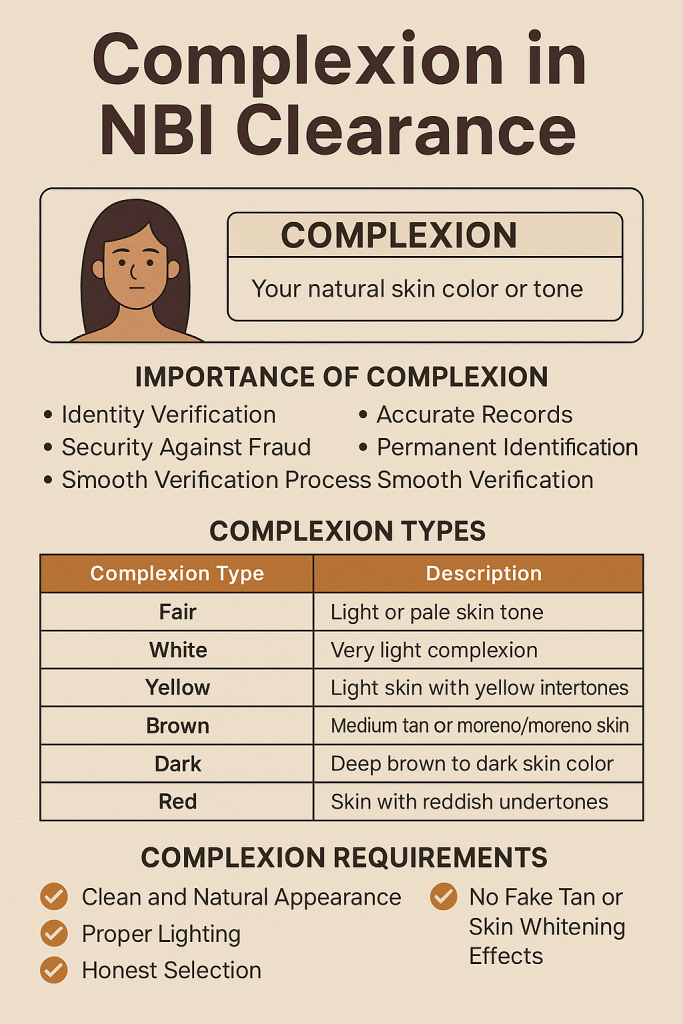What Is Complexion and Identifying Marks in NBI Clearance Complete Guide 2025
When filling out the NBI Clearance Form, one of the questions you’ll see is about your complexion. Complexion simply means your natural skin color or tone. It’s how your skin looks in normal daylight, whether it’s fair, brown, dark, or any other shade.
The National Bureau of Investigation (NBI) uses this information as part of your personal profile to make your clearance unique. Just like fingerprints or your photo, complexion helps identify you correctly. It is one of the many physical details NBI keeps to avoid confusion between people with similar names or appearances. Check your NBI Clearance validity before applying for job or other legal process.
So, when you fill in this part, you don’t need to worry about it too much. Just choose the option that best describes your skin tone naturally.
Importance of Complexion in NBI
Your complexion plays an important role in your identity verification process. NBI uses several personal details such as height, weight, eye color, hair type, and complexion to confirm that you are the right person linked to the record.
Here’s why complexion matters in your NBI clearance:
- Identity Verification:
If two people share the same name, the complexion helps NBI officers tell them apart easily. - Accurate Records:
A correct complexion record ensures your file remains accurate for future background checks, job applications, and visa purposes. - Security Against Fraud:
Including complexion details makes it harder for anyone to use someone else’s clearance or commit identity fraud. - Permanent Identification:
While you may change hairstyles or clothing, your natural skin tone remains mostly constant. That makes complexion a reliable physical marker. - Smooth Verification Process:
If you ever need to renew or recheck your record, the complexion data helps verify your identity quickly without confusion.
NBI Clearance Complexion Test
Many people think there’s a complexion test at NBI offices, but that’s not true. There is no test or machine to measure your skin tone. Instead, NBI staff will simply observe your complexion during your photo capture and interview.
When you apply online or in person, you might be asked to select your complexion from a list (Fair, Brown, Dark, etc.). The officer may double-check it when they take your photo to ensure that your selection matches your actual appearance.
It’s important to note that complexion is not used for any ranking, grading, or beauty standard. It’s purely for identification. So, there’s no need to worry about how light or dark your skin is , just be honest about your natural tone.
NBI Clearance Complexion Requirements
When applying for your NBI clearance, you don’t need to bring anything special for complexion verification. However, there are a few simple requirements to make sure your complexion is recorded properly:
- Clean and Natural Appearance:
When going for your NBI photo capture, make sure your face is clean and visible. Avoid heavy makeup or strong filters that might hide your natural skin tone. - Proper Lighting:
Your complexion is recorded based on how it appears in normal light. Try to sit facing the light source when taking your ID photo to reflect your true skin tone. - Honest Selection:
Choose the complexion that truly represents you. If you are unsure between two shades (for example, between fair and brown), pick the one that’s closer to your natural color. - No Fake Tan or Skin Whitening Effects:
Avoid temporary skin products that can mislead your record. Your NBI record should always match your real and lasting skin tone. - Update During Renewal:
If your complexion changes naturally over time (due to sun exposure or other reasons), you can update it when renewing your clearance.
Complexion in NBI Brown
One of the most common options chosen in the NBI form is Brown. The brown complexion usually refers to people with medium tan skin , not too light, not too dark.
In the Philippines, many people fall into this category. Brown complexion is often described as morena (for females) or moreno (for males). It covers a range of shades from light tan to medium brown.
If your skin looks sun-kissed, golden, or naturally tanned, “Brown” is likely the best choice for you. It’s the most accurate description for many Filipino applicants, especially those who spend time outdoors.
Complexion Types
In the NBI Clearance Form, you’ll usually find a list of several complexion types. These are general categories meant to represent different skin tones. You don’t need an exact match, just choose the one that fits you best.
Here are the main complexion types used by NBI and what they mean:
| Complexion Type | Description |
| Fair | Light or pale skin tone. Often seen in people with less sun exposure. |
| White | Very light complexion, usually referring to non-Filipino or foreign applicants. |
| Yellow | Light skin with yellow or golden undertones, common in East Asians. |
| Brown | Medium tan or morena/moreno skin tone, typical among many Filipinos. |
| Dark | Deep brown to dark skin color, common among those with strong sun exposure. |
| Red | Skin that appears reddish or has warm undertones, often due to natural pigmentation. |
Each category is broad, so don’t worry if your skin doesn’t match perfectly. Just pick the closest one.
Remember: there is no “perfect” complexion. Brown is just one of many natural shades, and it’s equally valid and beautiful as any other.
Fair Complexion
A Fair complexion means having a light or pale skin tone. People with fair skin may easily get sunburned and usually have a pinkish or creamy appearance.
In the NBI form, if your skin looks lighter than average, you can choose “Fair” or “White.” This usually applies to people who live in cooler areas, use sun protection regularly, or have lighter heritage.
However, keep in mind that complexion is not a matter of preference, it’s a matter of accuracy. Even if you think “Fair” sounds nicer, it’s better to choose what truly represents you. The goal is to make your NBI record real and reliable, not idealized.
Fair complexion is just one type among many. Whether you are fair, brown, or dark, all skin tones are equally valid in the eyes of NBI.
Conclusion
Complexion in the NBI Clearance Form is not a beauty measurement. it’s a security and identification detail. It helps NBI officers confirm who you are, especially if someone else has a similar name.
Choosing your complexion is easy. Look at your skin in natural light and pick the closest option (Fair, Brown, Dark, etc.). Be honest and don’t overthink it. If you ever renew your clearance and notice changes in your skin tone, you can update it.
By providing an accurate complexion, you make sure your clearance remains valid, safe, and trusted by employers, embassies, and other agencies that require background checks.

FAQ’s
What is complexion in NBI?
Complexion in the NBI Clearance form refers to your natural skin color or tone — how your skin looks under normal daylight. It’s recorded to help identify you correctly, just like your fingerprints or photo. Common options include Fair, Brown, Dark, White, Yellow, or Red. It is not a beauty rating, but purely an identification detail.
What is complexion in Police Clearance?
In a Police Clearance, complexion also means your skin tone or natural skin shade. Local police use it as one of the physical characteristics for identity verification, especially when people share similar names. It’s written in the personal information section along with height, weight, and eye color.
What is identifying marks?
Identifying marks are unique physical features that help authorities confirm a person’s identity. These may include moles, scars, birthmarks, tattoos, burns, or other visible features that make you different from others. They are used in many government forms to avoid identity mix-ups.
What is identifying marks in NBI Clearance?
In the NBI Clearance, identifying marks refer to any visible or unique mark on your body that helps verify your identity. For example, “Mole on left cheek” or “Scar on right arm.” These details are used for record accuracy and to prevent fraud or mistaken identity.
What is complexion in NBI Fair?
“Fair” complexion in NBI means a light or pale skin tone, often with a pinkish or creamy appearance. People with fair skin usually get sunburned easily and often have lighter features. If your skin looks lighter than average, you can choose Fair or White in the NBI form — but always select the option that truthfully represents you.
What is identifying marks in NBI example?
Here are a few examples of identifying marks you can write in your NBI Clearance form:
- Mole on right cheek
- Scar on left hand
- Tattoo on right arm
- Birthmark on neck
- Burn mark on left leg
If you don’t have any visible marks, you can simply write “None”.







One Comment